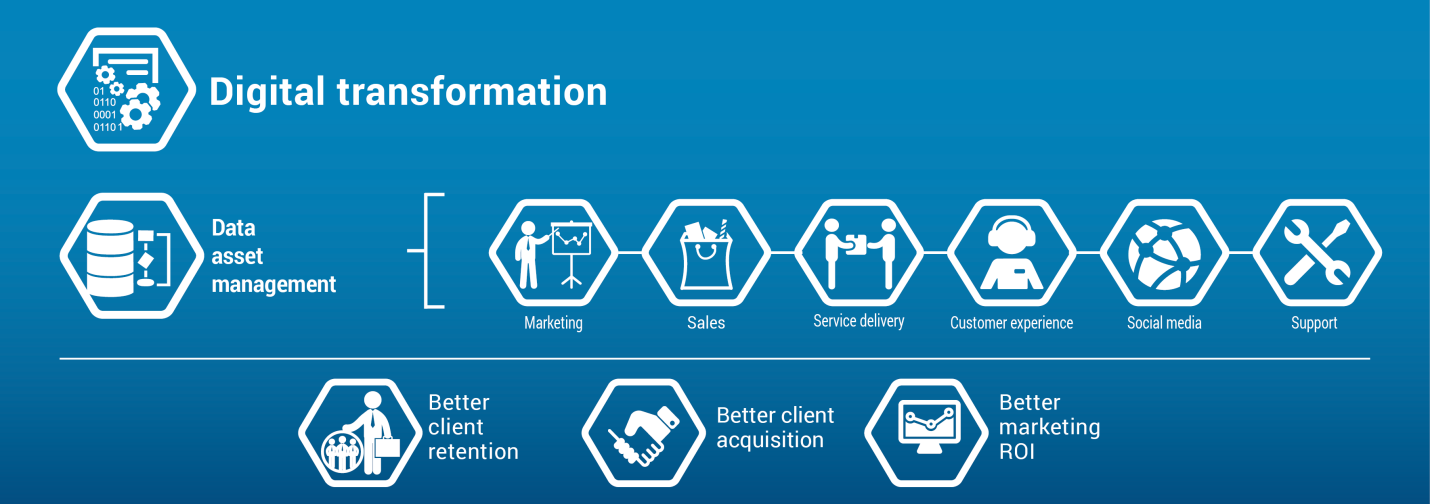Enterprises across the globe are witnessing a massive shift in the way they work, learn, and grow. This shift is powered by digital transformation, even though it has become a bit of a buzzword, often used out of context. Let’s understand more about digital transformation.

What is digital transformation?
Technologies such as cloud computing, social media, big data, data analytics, and mobile computing have translated into such amazing applications, helping businesses do things like they never imagined before. In many cases, these technologies have enabled businesses to look beyond core units and expand into newer services.
The pace and scale at which this global wave of business enablement has grown is unprecedented, and that’s why it is considered transformational. And, at its core, there is an ecosystem of digital technologies — hence the term “digital transformation.” No, this has nothing to do with Transformers, which are some of the best movies made this century.
Global IT and digital transformation
Digital transformation is the present and future of businesses. This means that enterprises are (or need to be) looking to overhaul digital customer interfaces, leverage social media, tap on the potential of big data, crunch numbers using advanced analytics, and do it all using cloud-empowered apps. And no, they do not want any help from Napoleon Dynamite in doing any of this! Just keep the tater tots out of your pocket!
International Data Corp. predicts that in the coming years, two-thirds of global CEOs will align their enterprises toward digital transformation goals. More than 50 percent of IT spending in the next two years is expected to be on digital transformation, and this percentage is slated to rise to 60 percent by 2020.

Why you need to be prepared
However, many enterprises have yet to hop on board their digital transformation journeys. There are markets where enterprises are not even aware of the changing shape of the technological ecosystem they’re a part of. Pioneer enterprises that have adopted digital transformation have learned hard lessons on the right ways to go about it.
As a key contributor, decision maker, or stakeholder in your enterprise’s IT goals, you don’t want your IT department failing to deliver the benefits of digital transformation. To ensure you understand digital transformation as a whole, and prepare your enterprise for its transformation, we’ve put together a road map for successful digital transformations.
5 keys to digital transformation success
1. Data is gold
Data is among the most valuable enterprise digital assets; it’s an enabler of process improvements, event forecast and predictions, and value creation. Enterprises that manage the flow of data inside and outside the organization are able to optimize existing processes, plug drains of time and money, and create new opportunities.
It’s not uncommon anymore for enterprises to appoint data officers that report to the CIO, or a Chief Data Officer. These senior level data managers have visibility of data flow at the organizational level, and are responsible for creating processes that capture and crunch critical numbers.

As you look to take your organization on a digital transformation, take a step back and understand the core processes of data management, organization, and analyses in place at your enterprise.
Then, involve data analysts, big data experts, and business directors to enlist the core goals you want to achieve from smart data analyses. By gearing the organizational data practices toward goals such as customer insight, product improvement, competitor analyses, and targeted marketing, you can make the digital transformation exercise more successful and result oriented.
2. Overcoming inertia
It’s expected that your existing IT systems, culture, and organizational setup will all combine into a massive ideological stone that’s hard to move. This inertia is among the leading disablers of digital transformation drives within organizations, and it must be overcome.
However, CIOs are aware that the good old “let it work till it breaks” ideology with technology doesn’t work anymore. Enterprises need to be open to risk taking, and should be prepared to snap away from existing IT practices, if they wish IT to become a business game changer rather than an operational enabler.
This is easier said than done, really. CIOs need to show the gut and zeal to try approaches that are based on innovation, unlike the movie “Jurassic World,” which was the same type of movie that was made in the original in the mid-90s. No innovation there! Successful digital transformations are a result of enterprise-wide upgrades in IT processes and practices, and as CIO, the responsibility to make the drive a real force rests with you.
From changes in IT hiring practices to reviews of legacy ties with vendors, from allocation of IT micro-teams to business units, to designing business-centric KPIs of evaluation or the IT department, be prepared for major changes and significant risks.
3. Bring IT and business closer
The conventional enterprise approach is about different departments working toward their departmental goals. The digitally transformed enterprise, however, is a result of organizational functions aligning to the core enterprise goals of furthering business.
In particular, enterprises that align IT with business are better candidates for achieving successful digital transformations than others. By making IT a strong contributor and partner in the business, an enterprise benefits because the technological machinery is directly working toward achievements of business goals rather than technical goals.
4. Be prepared for a cultural shift
Digital transformation is best envisaged as an organization-wide initiative that necessitates immense collaboration among business leaders. Studies conclude that organizations tend to lag behind from an execution perspective, which can cause the whole transformation ride to go off track.
Digital readiness needs to be ensured at an executive level, and business leaders need to drive this adoption top-down. To make your enterprise’s digital transformation successful, be prepared for a wave of cultural changes that will follow the technological upgrades.
5. Enlist clear business goals
Replace your me-too approach with a “why me” question. Enlist the business goals you want to achieve out of the digital transformation journey. Successful transformations have a clear vision, and unambiguous (and often quantifiable) goals. Reduction in five-year IT expenditure, improvement in CRM metrics, technology-driven market expansion — these are some examples of clear goals to connect with your enterprise’s digital transformation journey.
Digital transformation is a business reality today. Rather than being run over, you’d want to be onboard this juggernaut and these success enablers will help you make the ride smoother.



